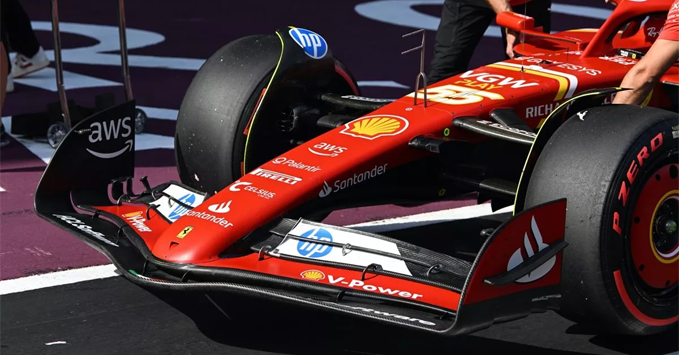Flexible wing: FIA delay in making a decision cost Ferrari "one or two months" of development

11/14/2024 12:42 PM
Ferrari has acknowledged that it was slow to take advantage of the benefits offered by flexible wings in Formula 1, largely because it was under the impression that the FIA would intervene and clamp down on the practice.
In the current generation of Formula 1 cars, teams have discovered that harnessing the aerodynamic flexibility of front wings can be an extremely effective way to mitigate issues such as low-speed understeer and high-speed oversteer, both inherent characteristics of ground effect cars. When optimized, a flexible front wing can provide significant balance improvements, which is why teams like McLaren and Mercedes have made considerable strides throughout the season in refining their designs.
Ferrari, after initially holding back, began using a new flexible front wing design starting at the Singapore Grand Prix, hoping to gain a performance advantage in this area. This coincided with a resurgence in form for the Italian team, highlighted by victories in the United States and Mexico City.
Team principal Frederic Vasseur explained that Ferrari had delayed pursuing this concept more aggressively because of its belief that the FIA’s investigation into flexible wing behavior, which began at the Belgian Grand Prix, would lead to stricter regulations that would limit or ban the practice. However, as Ferrari later discovered, the FIA decided to allow teams to continue with their designs, signaling that they saw no need to change the existing rules.
Speaking to the Motorsport website about the situation with flexible wings, Frederic Vasseur elaborated on Ferrari’s initial hesitation and subsequent realization that the FIA would not take action to restrict the use of this technology.
"There was frustration because at one stage we were waiting for the decision of the FIA when they installed the cameras [from the Belgian GP]. We were convinced that it will go for the 'no go'. And it went for the ‘go’! So probably we lost one or two months."
Frederic Vasseur explained that Ferrari's cautious approach in developing a front wing design capable of better utilizing aerodynamic elasticity was also shaped by the financial constraints imposed by Formula 1's cost cap. Given these restrictions, the team was hesitant to invest valuable resources into a design that could ultimately be deemed illegal or banned before it could be used in a race. The potential waste of time and money, if the concept was later prohibited, made Ferrari more reluctant to aggressively pursue the development of the flexible wing at that stage.
"It’s difficult because with the cost cap you have to make your choices," added Fred Vasseur – "It means that if you are convinced that it won’t be allowed, and you have start to develop something, then it’s costing you a time in the wind tunnel. But it was our decision."
Starting from the Belgian Grand Prix, the FIA significantly increased its scrutiny of front wing flexing across the teams. This included the installation of additional video cameras and the use of extra monitoring stickers, designed to provide a more detailed understanding of how the aerodynamic components were behaving during race conditions.
Recently, in discussing the findings of these investigations, the FIA's head of single-seater racing, Nikolas Tombazis, explained that the governing body's conclusion was that, due to the varying approaches adopted by different teams, it would have been unjust to implement any immediate changes to the regulations governing flexible wings. The diversity in how teams were using the technology made it difficult to justify a sudden shift in the rules, as it would not have been fair to impose new restrictions without a more thorough evaluation of the situation.
"Because the front wing gets loaded in different ways, we cannot predict it easily in the regulations," he said – "As no two wings have exactly the same loading pattern, it is very difficult to come with a proper test. So, as these rules have been around since 2022, we felt it was a bit knee jerk to suddenly say that for 2025 we were going to change it, or indeed change something for 2024. But we are using this information we’re gathering to perhaps lead us to something a bit more effective for 2026." – Nikolas Tombazis concluded.
The post Flexible wing: FIA delay in making a decision cost Ferrari “one or two months” of development appeared first on Scuderia Fans.


